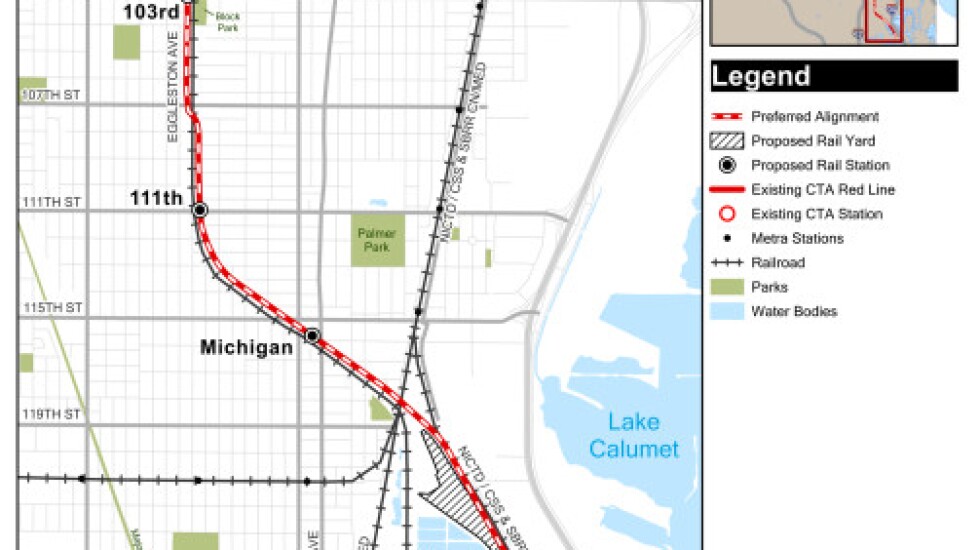
A couple weeks ago, there was an event in town that politicians treated as a celebration. It may, instead, have been a mistake compounded for taxpayers.
VIPs gathered to herald the federal government’s decision to provide $2 billion toward the cost of the CTA’s Red Line extension, which would run from 95th to 130th streets. CTA President Dorval Carter Jr. said the money ensured the transit authority could begin engineering work, the last step before construction. It’s an estimated $3.7 billion project before inevitable cost overruns.
For that, the CTA gets a 5.6-mile extension with four new stations, including a new terminus at the Altgeld Gardens public housing complex.
There currently is no CTA L service south of 95th Street. No one can argue that residents of the Far South Side don’t deserve rapid transit. They could have gotten it decades ago if politicians and transit agencies thought ahead.

The CTA lists many reasons to support the project and wraps it in the mantle of racial justice, as the communities to benefit are mostly African American. But there’s an “emperor has no clothes” aspect here. It becomes clear if you look at a map. There are five commuter rail lines in Chicago south of 95th that carry thousands of people every day.
Two go right by Altgeld Gardens. One is the Metric Electric service to the southern suburbs, which passes the housing project to the west. The other is the South Shore line that connects Northwest Indiana to Chicago and passes Altgeld to the east. Granted, neither line has a station at 130th Street, but building one and adding service on existing tracks ought to be cheaper than the CTA’s plan.
Two more rail routes are branches of the Rock Island service through either Washington Heights or Beverly on their way to the suburbs. The last line is a Metra Electric spur through Pullman that ends at Blue Island.
So the CTA is prepared to spend $3.7 billion to add a sixth line to a region where five already exist.
The criticism here is not original, just rarely expressed.
In November 2022, transportation consultant Ed Zotti, a former colleague, boldly entered this void with a piece in Crain’s Chicago Business that argued the Red Line extension was too costly and unlikely to produce the promised benefits. He argued that on a cost-per-ride basis, the Red Line extension was likely to be one of the most expensive transit deals in history. And Zotti went to the maps, too.
“The oft-stated goal of the Red Line extension is to do right by the underserved residents of the Far South Side. At some point the realization ought to have dawned: There’s already a railroad down here!” Zotti wrote. “We don’t have to build another one! We could massively improve service without waiting 20 years!”
Zotti’s piece was a fact-based and devastating takedown. Yet, he told me it produced little reaction, and he even lamented in the article that few people wanted to go on record for it. Transportation experts seem disinclined to criticize something that has political momentum. There’s a widespread sense that any public transit expansion is a good project. Also, the CTA would get a roomier rail yard out of the deal, something it arguably needs.
The Red Line extension threatens to be just a public works boondoggle, maybe the biggest in the planning stage since former Mayor Richard M. Daley wanted to shut down Midway Airport and rebuild it near Lake Calumet 30 years ago. But at least that plan collapsed under its own weight.
One politician showing some understanding is Cook County Board President Toni Preckwinkle, who rolled out a “Fair Transit South Cook [County]” program that enlisted Metra and Pace, the suburban bus service, in offering reduced fares and more frequent service. Even through the pandemic, the program has reported success in attracting ridership. The county uses motor fuel tax money to reimburse the transit agencies, but the program has yet to reach its goal of simplifying transfers.
Chicago’s transit systems are bifurcated and serve different masters. The CTA is controlled by the mayor, while Metra is beholden to the suburbs. They are all suffering from ridership that’s still far less than prepandemic levels, so they’re getting reduced revenue from the fare box. Together, these agencies are looking at a deficit of $730 million by 2026 once the federal government’s COVID relief money runs out.
What to do about it? Reconsider costly projects? Consolidate the transit agencies to save money? Nah, how about raising the sales and motor fuel taxes to support transit? The political class that needs big projects to create moneymaking opportunities for campaign donors will go for that one. Watch for it.
The Red Line extension rolls on into a fiscal storm. Is there anybody to stop this runaway train?








